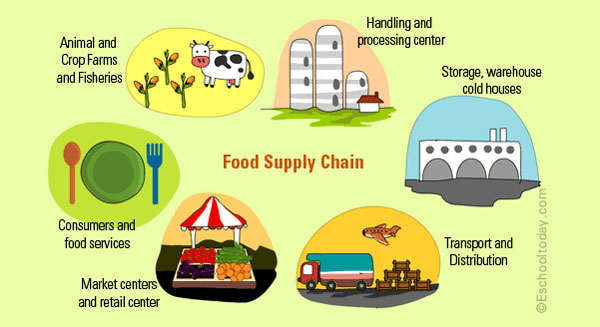- Food waste/loss
Where is food lost and wasted?
Between the time food leaves the farms and reaches our homes, food goes through several processes that make up a long chain called the Food Supply Chain (FSC).

Let us see each stage of the FSC and the kind of waste that occurs there:
Agricultural Production:
Waste and losses here result from mechanical damage, where farming equipment accidentally damages the fruits and vegetables. It also includes spills and attacks by insects and other diseases. Losses on animals resulting from diseases and deaths during breeding also fall here. Fish discards are also a factor.
Harvest, post-harvest handling, storage:
There are losses here too, resulting from the handling of the fruits (foods) during harvesting, storage, and transporting of the produce from farms to the processing centers. This is the same for animal farms, where there are losses to animals at the slaughterhouses, as well as meat and fish going bad at storage centers.
In India for example, about 21 million tonnes of wheat annually perish due to inadequate storage and distribution, equivalent to the entire production of Australia. (1)
Processing:
Food products that are processed into juices, can foods and pastries also get wasted at the processing centers. During peeling, slicing, boiling, and sorting, lots of food are trimmed away by the processing equipment. This is similar to dairy production, where milk is lost during pasteurizing. Some losses also occur during fish canning, smoking, and salting.
Distribution:
At the market centers, lots of fresh food rot and get thrown away. In wholesale and retail shops, foods reach their expiry dates and get thrown away. Processed foods such as juices, milk, oil, and soups spill each day in many markets and grocery centers.
Consumption:
These include all losses from food services, homes, schools, hospitals. Lots of pastries, milk, juices, and food are thrown away because they were unsold or were not eaten. Of the quantity that does reach the supermarket shelves, 30–50% is thrown away by the final purchaser in the home.(2)
Sources
1,2 GLOBAL FOOD WASTE NOT,WANT NOT. http://www.imeche.org/docs/default-source/reports/Global_Food_Report.pdf?sfvrsn=0
